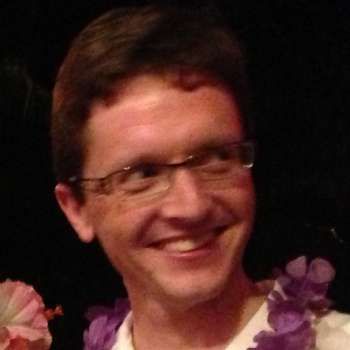Once again, Opera Australia’s summer season in Sydney finished with its now annual show on a platform in the waters of Farm Cove. The six previous HOSH (Handa Opera on Sydney Harbour) productions featured operas by Bizet (Carmen in 2013 and 2017), Verdi (Traviata in 2012 and Aida in 2015) and Puccini (Butterfly in 2014 and Turandot in 2016). Puccini has now pulled ahead, thanks to the current Bohème.
One’s enjoyment of the Harbourside operas is very weather-dependent: seating and stage are both uncovered, and those of my acquaintances who had attended the dress rehearsal earlier in the week reported damp experiences. On opening night conditions could not have been better, and the opera was performed in balmy temperatures against the spectacular backdrop of the Sydney cityscape.
Glitz and glamour are very much part of HOSH, but on this occasion they felt well-integrated into the story. Earlier shows featured giant Egyptian heads, oriental dragons and the like, whereas Dan Potra’s set was less flamboyant: the main structure upstage contained the artists’ apartment, a level above the street area downstage. Much use was made of projections onto the large dormer window of the apartment: at times it showed the ostensible view (with the Eiffel Tower establishing the location), but during the Act 1 love duet the images panned up and revealed increasingly fanciful night skies.
Director Andy Morton updated the Belle Époque story to the 1960s, another period where Paris was a centre of counter-cultural intellectual and artistic activity. Potra’s costumes suggested this decade even before the subtitles mentioned De Gaulle, or the smouldering overturned cars in Act 3 established a link to the student riots of May 1968. The wintry weather frequently referenced throughout Acts 1-3 explained the snowdrifts and icicles around the edge of the stage, and there was even snow falling in the light of the old streetlamps (foam rather than the paper that might be used indoors).
The first Act of La bohème is in many ways the perfect combination of extroversion and intimacy: first the lively banter and playacting of the four friends (and their tricking the querulous landlord) and then the initial encounter between the soon-to-be-lovers. With all singers miked, there was good vocal balance between the men, and the horseplay came over well. Samuel Dundas as Marcello exuded lots of swagger and bravado, but Ho-Yoon Chung as Rodolfo was not far behind in the acting stakes. The real revelation in this act was Iulia Maria Dan as Mimì – her dark tone was almost mezzo-like, unexpected but very appealing. Chung’s rendition of the show-stopping “Che gelida manina” was highly lyrical, and the final duet “O soave fanciulla” a delight.
Act 2 opened with a carnivalesque street-scene featuring stilt walkers, torch jugglers, unicycles and a clown in a hot-air balloon, who departed towing a child on the end of his rope. Julie Lea Goodwin brought both vocal fireworks and gallons of glamour as Musetta: her by-play with her sugar daddy while trying to win Marcello back was brilliantly executed. For once, the obligatory fireworks were well-positioned at the end of this act, when everything seems to be working out, and life and love are on course.
It can’t last, of course – this is Italian opera – and Act 3 sees the two relationships strain to breaking point against a backdrop of sleaze and civil unrest. The hints of the demi-monde in the original were turned into the red-light-district windows and the sex-worker costumes here. Top design marks for perfect coordination of the firing of the gun with the street lamp going out. The shouting match between Marcello and Musetta acted as a foil for the more gentle fraying of the Rodolfo-Mimì connection, with all four singers engaging the audience vocally.
The final act recapitulates much of the action of the first, although with a new admixture of regret and bitterness even before the final tragedy. Colline’s “Vecchia zimarra” had a sincerity and understated expressivity that won Richard Anderson a deserved round of applause. Christopher Hillier as Schaunard was also strong throughout the night.
So singers were all on form, and the production was intelligible and visually attractive: what could be wanting? The one major caveat I had was the sound production, which was loud to the verge of discomfort. Speaking with several acquaintances at the interval, only those seated at a considerable distance reported no problems. Brian Castles-Onion, an experienced hand at these productions, coordinated the whole enterprise well from the podium. The message to sound designer Tony David Craig should be: one can have too much of a good thing.




